Microsoft RM-680 GSM/WCDMA cellular phone w/BT and WLAN User Manual manual
Microsoft Mobile Oy GSM/WCDMA cellular phone w/BT and WLAN manual
manual

Nokia N950 User Guide
9225011
Issue 1
Cyan
Cyan
Magenta
Magenta
Yellow
Yellow
Black
Black
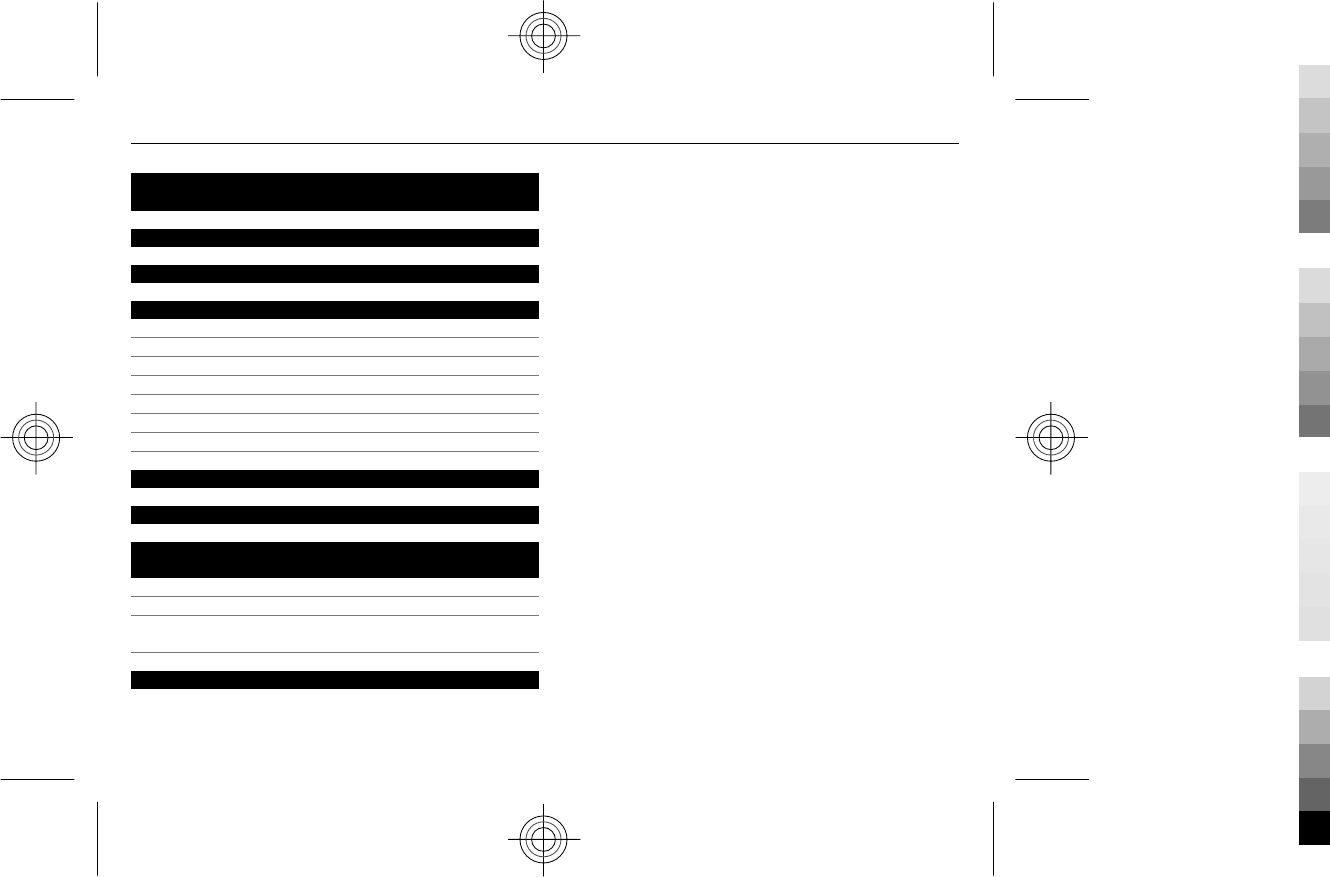
Contents
Safety 3
Welcome, developer! 4
Get started 4
Front 4
Sides 5
Back 6
Labels on the device 6
Insert or remove the SIM card 6
Charge the battery 7
Switch the device on or off 8
Status area indicators 8
Access codes 9
Keep the device software and applications up to
date 9
About device software and application updates 9
View your software version 10
Update device software and applications using the
device 10
Product and safety information 10
2
Cyan
Cyan
Magenta
Magenta
Yellow
Yellow
Black
Black
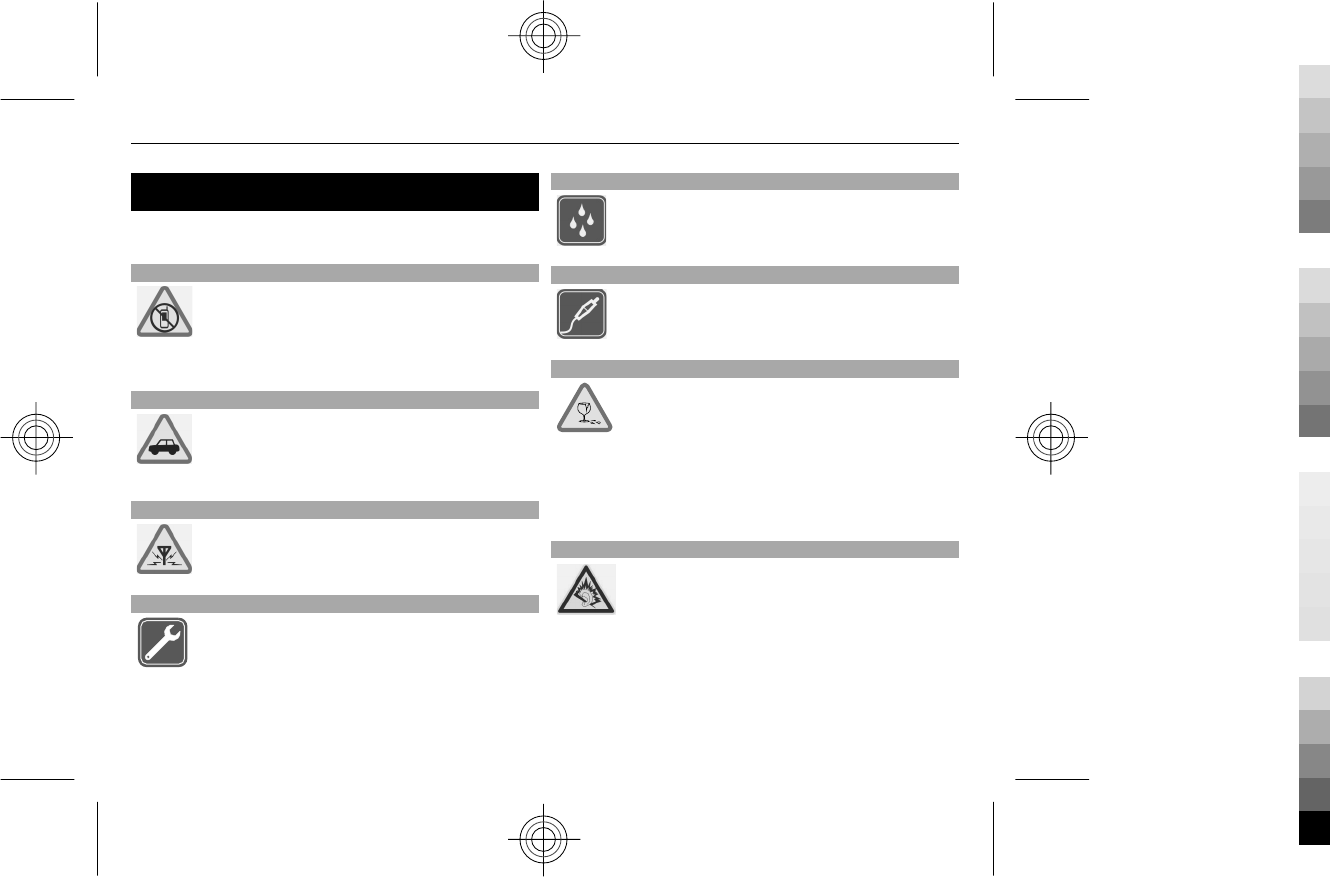
Safety
Read these simple guidelines. Not following them may be
dangerous or illegal.
SWITCH OFF IN RESTRICTED AREAS
Switch the device off when mobile phone use
is not allowed or when it may cause
interference or danger, for example, in aircraft,
near medical equipment, fuel, chemicals, or
blasting areas.
ROAD SAFETY COMES FIRST
Obey all local laws. Always keep your hands free
to operate the vehicle while driving. Your first
consideration while driving should be road
safety.
INTERFERENCE
All wireless devices may be susceptible to
interference, which could affect performance.
QUALIFIED SERVICE
Only qualified personnel may install or repair
this product.
KEEP THE DEVICE DRY
The device is not water-resistant. Keep it dry.
BATTERIES, CHARGERS AND OTHER ACCESSORIES
Use only batteries, chargers, and other
accessories approved by Nokia for use with this
device. Do not connect incompatible products.
GLASS PARTS
The front cover of the device is made of glass.
This glass can break if the device is dropped on
a hard surface or receives a substantial impact.
If the glass breaks, do not touch the glass parts
of the device or attempt to remove the broken
glass from the device. Stop using the device
until the glass is replaced by qualified service
personnel.
PROTECT YOUR HEARING
Listen to a headset at a moderate level, and do
not hold the device near your ear when the
loudspeaker is in use.
3
Cyan
Cyan
Magenta
Magenta
Yellow
Yellow
Black
Black

Welcome, developer!
This device is not commercially available. It is targeted to
application developers only and is subject to any
agreement made between you and Nokia regarding the
device, such as the product loan agreement (PLA).
The hardware and software of this developer device may
differ from any final commercial product.
The device contains the following:
•The software development kit (SDK), which is a set of
programming tools to be installed on the
development host computer. The device contains the
SDK for Windows, Mac OS X, and Linux.
•In-device tools, such as a terminal application and
Nokia Energy Profiler. Some of the tools have a
graphical user interface and can be found with the
other applications, others can only be used using a
command-line interface. To disable the tools, select
and Security > Developer mode, and deactivate
Developer mode. Do not remove the tools.
Install the software development kit
1 Connect the device to the development host computer
using a data cable.
2On the device, select Mass storage.
3 Using the file manager of your computer, browse to
the SDK directory on the device.
4 Select the correct installation file for your computer's
operating system: SDK-installer-windows.zip, SDK-
installer-os-x.dmg for Mac OS X, or SDK-installer-
linux-32bit.bin or SDK-installer-linux-64bit.bin
for Linux.
5 Copy the file to your computer.
6 Double-click the file.
7 Follow the displayed instructions.
For more information on a tool, select and Security >
Developer mode and the tool.
For support information, go to www.forum.nokia.com/
MeeGo.
Get started
Front
1Front camera lens
2Notification light
4
Cyan
Cyan
Magenta
Magenta
Yellow
Yellow
Black
Black
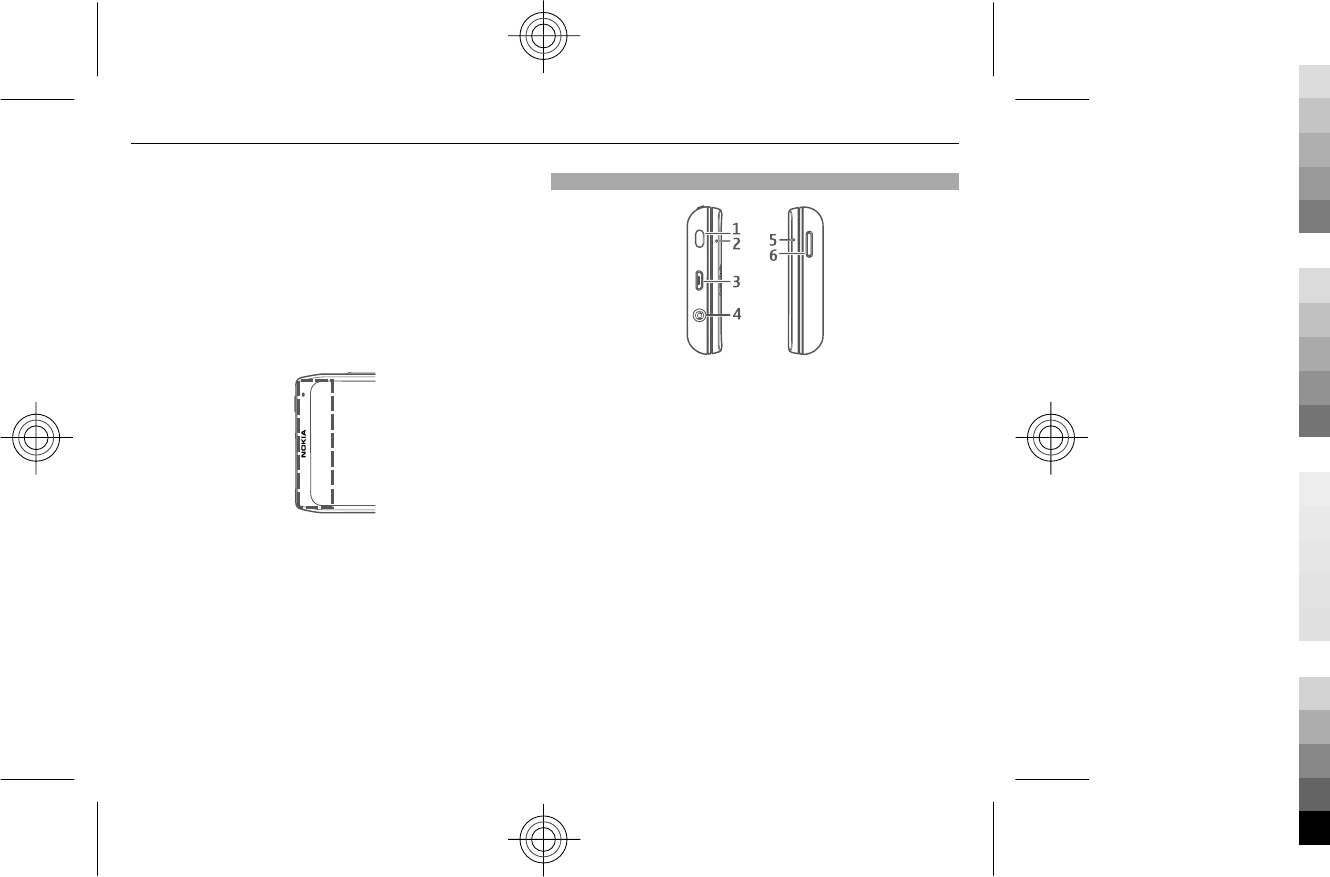
3Light sensor
4Earpiece
5Touch screen
6Physical keyboard
To ensure proper functionality of the touch screen,
remove the protective film from the device display.
Do not cover the area left of the touch screen with, for
example, protective film or tape.
If you slide open the keyboard during a call, the call audio
is routed to the loudspeaker or connected compatible
headset.
Sides
1Power key
2Microphone
3Charger and data cable connector
4Nokia AV connector (3.5 mm)
5Microphone
6Loudspeaker
Do not connect products that create an output signal as
this may cause damage to the device. Do not connect any
voltage source to the Nokia AV connector. If you connect
an external device or headset, other than those approved
by Nokia for use with this device, to the Nokia AV
connector, pay special attention to volume levels.
5
Cyan
Cyan
Magenta
Magenta
Yellow
Yellow
Black
Black

Back
1Volume key
2SIM card slot
3Camera flash
4Camera lens
Labels on the device
The CE mark of the device is located under the touch
screen.
The Federal Communications Commission (FCC)
identification number is printed on the back of the touch
screen.
Insert or remove the SIM card
Important: Do not use a mini-UICC SIM card, also
known as a micro-SIM card, a micro-SIM card with an
adapter, or a SIM card that has a mini-UICC cutout (see
figure) in this device. A micro SIM card is smaller than the
standard SIM card. This device does not support the use
of micro-SIM cards and use of incompatible SIM cards may
damage the card or the device, and may corrupt data
stored on the card.
Do not attach any stickers to your SIM card.
Insert the SIM card
1 Use your fingernail to open the cover of the SIM card
slot.
6
Cyan
Cyan
Magenta
Magenta
Yellow
Yellow
Black
Black

2 Make sure the contact area of the SIM card is facing
up, and insert the card into the SIM card slot. Push the
card in until it locks into place.
3 Close the cover of the SIM card slot.
Remove the SIM card
1 Use your fingernail to open the cover of the SIM card
slot. Push the SIM card in to release it.
2 Remove the SIM card.
Charge the battery
The battery has been partially charged at the factory, but
you may need to recharge it before you can switch on the
device for the first time.
If the device indicates a low charge, use a compatible data
cable to connect to a compatible device, such as a
computer.
7
Cyan
Cyan
Magenta
Magenta
Yellow
Yellow
Black
Black
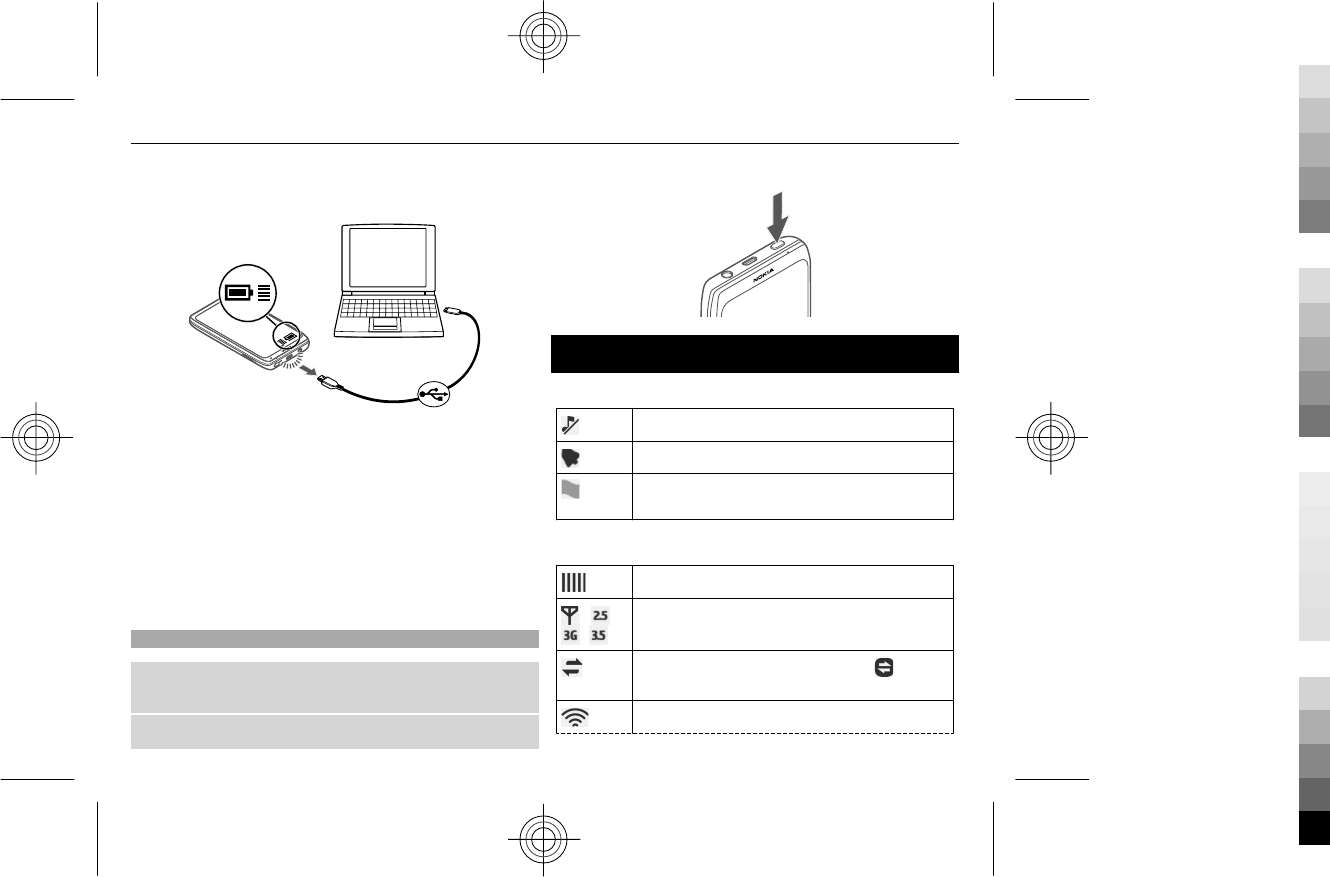
To avoid breaking the charger connector, be careful when
connecting or disconnecting the charger cable.
You do not need to charge the battery for a specific length
of time, and you can use the device while it is charging.
Charging over data cable can take longer to start and you
may not be able to use the device immediately. Charging
may not work if you connect the data cable to a non-
powered hub.
If the battery is completely discharged, it may take several
minutes before the charging indicator appears on the
display or before any calls can be made.
Switch the device on or off
To switch on the device, press and hold the power key
until the device vibrates.
To switch off the device, press and hold the power key.
Status area indicators
General indicators
The silent profile is activated.
You have set a clock alarm.
You have new notifications (for example, new
messages or missed calls).
Network indicators
Signal strength.
/ /
/
Your current network.
A packet data connection is open.
indicates that data is being transferred.
You are connected to a WLAN.
8
Cyan
Cyan
Magenta
Magenta
Yellow
Yellow
Black
Black
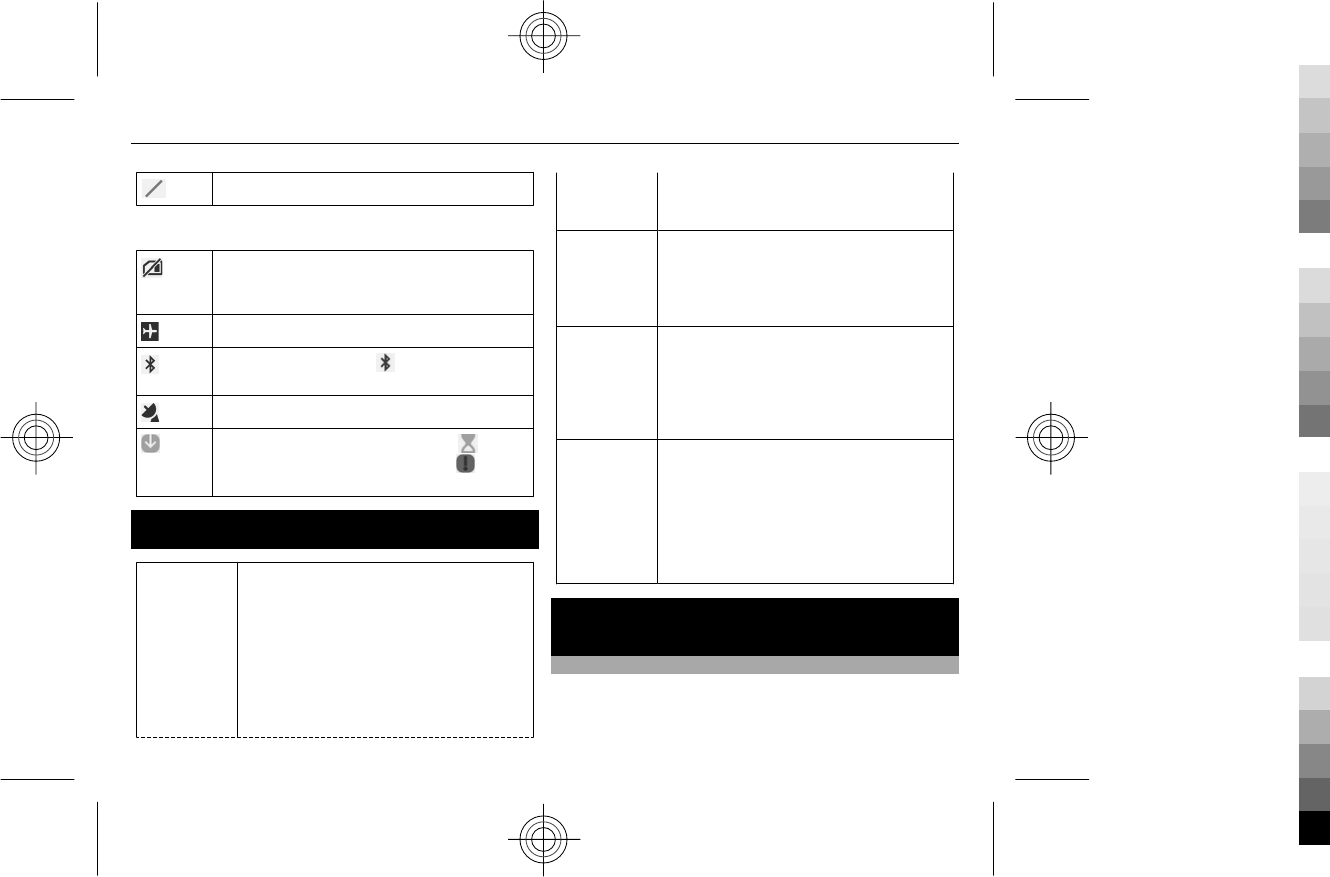
There are no available networks.
Connectivity indicators
The SIM card is not available. The card is not
inserted or the PIN code has not been
entered.
The offline profile is activated.
Bluetooth is activated. indicates that data
is being transferred.
GPS is activated.
The device is transferring content.
indicates that transfer is pending.
indicates that transfer has failed.
Access codes
PIN or PIN2
code
These protect your SIM card against
unauthorised use or are required to
access some features.
You can set the device to ask for the PIN
code when you switch it on.
If not supplied with your SIM card or you
forget the codes, contact your service
provider.
(4-8 digits) If you enter the code incorrectly three
times in a row, you need to unblock the
code with the PUK or PUK2 code.
PUK or PUK2
code
(8 digits)
These are required to unblock a PIN or
PIN2 code.
If not supplied with your SIM card, contact
your service provider.
IMEI number
(15 digits)
This is used to identify valid devices in the
network. The number can also be used to
block, for example, stolen devices.
To view the IMEI number of the device,
dial *#06#.
Lock code
(security
code)
(min. 4 digits
or
characters)
This protects the device against
unauthorised use.
You can set the device to ask for the lock
code that you define.
Keep the code secret and in a safe place,
separate from the device.
Keep the device software and applications up
to date
About device software and application updates
With device software updates and application updates,
you can get new features and enhanced functions for the
device. Updating the software may also improve the
device performance.
9
Cyan
Cyan
Magenta
Magenta
Yellow
Yellow
Black
Black
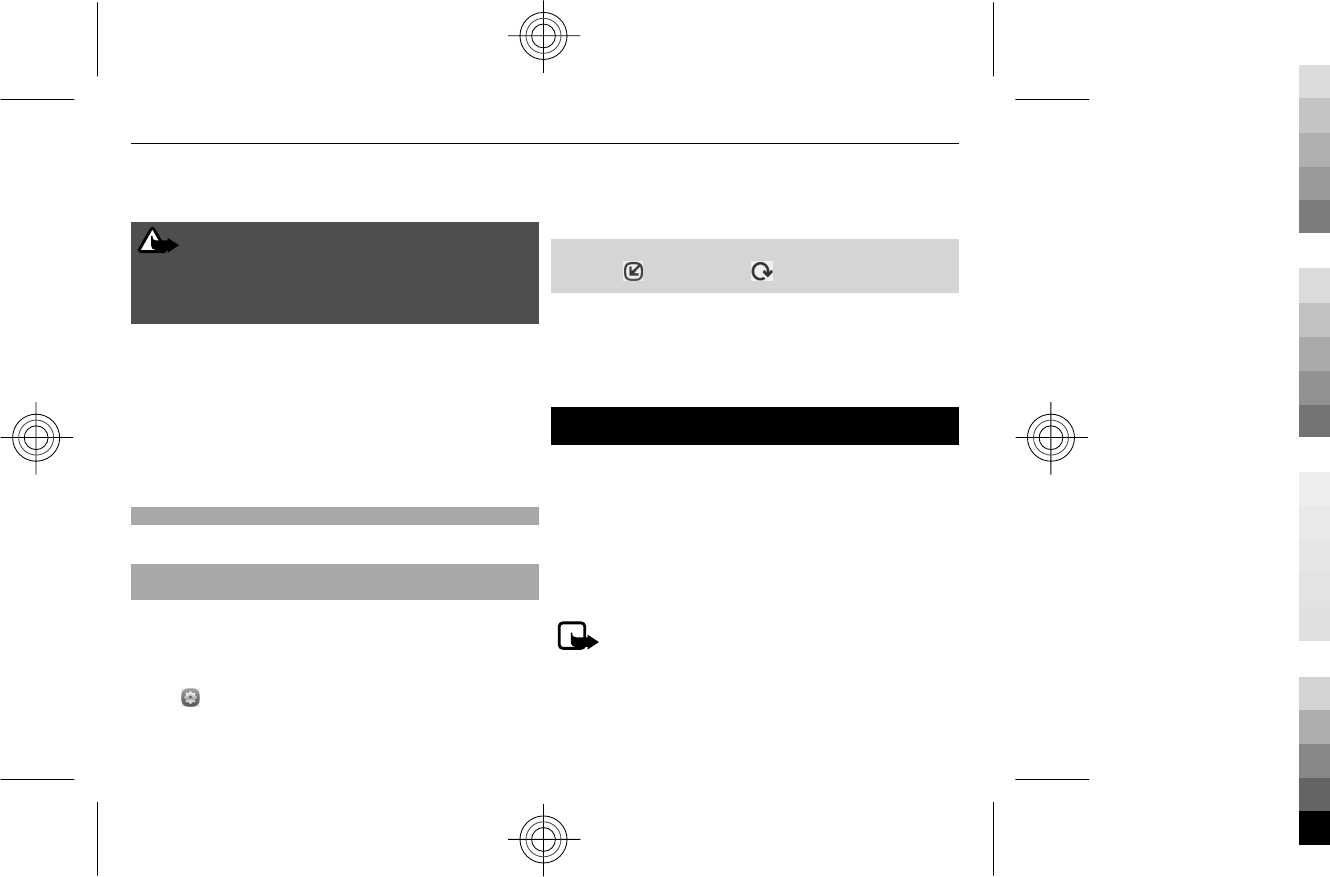
It is recommended that you back up your personal data
before updating the device software.
Warning:
If you install a software update, you cannot use the device,
even to make emergency calls, until the installation is
completed and the device is restarted.
Using the service or downloading content may cause
transfer of large amounts of data, which may result in data
traffic costs.
Make sure that the device battery has enough power, or
connect the charger before starting the update.
After the update, the instructions in the user guide may
no longer be up to date.
View your software version
Dial *#0000#.
Update device software and applications using the
device
You can check if there are updates available for the device
software or for individual applications, and then
download and install them to the device (network
service).
Select > Applications > Manage applications.
When an update is available for an installed application,
a notification message is displayed. To view and install
the available update, select the notification message.
Check for updates manually
Open the tab, and select to refresh the view.
You can update individual applications or all available
applications.
To prevent any possible loss of data, back up your data
before installing operating system updates.
Product and safety information
Feature-specific instructions
The Assisted GPS (A-GPS) network service retrieves location information using the
cellular network, and assists GPS in calculating your current location.
The availability and quality of GPS signals may be affected by your location, satellite
positions, buildings, natural obstacles, weather conditions and adjustments to GPS
satellites made by the United States government. GPS signals may not be available
inside buildings or underground.
Do not use GPS for precise location measurement, and never rely solely on the
location information provided by GPS and cellular networks.
Note: Using WLAN may be restricted in some countries. For example, in
France, you are only allowed to use WLAN indoors. For more information, contact
your local authorities.
Use of the Mail for Exchange is limited to over-the-air synchronisation of PIM
information between the Nokia device and the authorised Microsoft Exchange
server.
10
Cyan
Cyan
Magenta
Magenta
Yellow
Yellow
Black
Black

Network services and costs
The device is approved for use on the WCDMA 850, 900, 1900, 1700/2100, 2100 and
GSM/EDGE 850, 900, 1800, 1900 MHz networks.
Using network services and downloading content to the device requires a network
connection and may result in data traffic costs. Some product features require
support from the network, and you may need to subscribe to them.
When using this device, obey all laws and respect local customs, privacy and
legitimate rights of others, including copyrights. Copyright protection may prevent
some images, music, and other content from being copied, modified, or transferred.
Open source software notice
This product includes certain open source software. Nokia offers to provide you with
the source code as defined in the applicable licence. Please send an e-mail to
sourcecode.request@nokia.com or a written request to:
Source Code Requests
Nokia Corporation
P.O.Box 226
FI-00045 Nokia Group
Finland
This offer is valid for a period of three (3) years from the date of the distribution of
this product by Nokia. By submitting a request, you give your consent that Nokia (or
third parties on behalf and under direct authority of Nokia) will process your
personal data. The processing will be done for the purpose of the request and the
undertakings related to it. The main reason for storing this data is to prove
compliance with the licence terms. The data processing will be done in compliance
with Nokia guidelines and applicable legislation.
Take care of the device
Handle the device, battery, charger, and accessories with care.
•Keep the device dry. Precipitation, humidity, and all types of liquids or
moisture can contain minerals that corrode electronic circuits. If the device
gets wet, allow the device to dry.
•Do not use or store the device in dusty or dirty areas. Moving parts and
electronic components can be damaged.
•Do not store the device in high temperatures. High temperatures can shorten
the life of the device, damage the battery, and warp or melt plastics.
•Do not store the device in cold temperatures. When the device warms to its
normal temperature, moisture can form inside the device and damage
electronic circuits.
•Do not attempt to open the device other than as instructed in the user guide.
•Unauthorised modifications may damage the device and violate regulations
governing radio devices.
•Do not drop, knock, or shake the device. Rough handling can break internal
circuit boards and mechanics.
•Only use a soft, clean, dry cloth to clean the surface of the device.
•Do not paint the device. Paint can clog the moving parts and prevent proper
operation.
•Keep the device away from magnets or magnetic fields.
•To keep your important data safe, store it in at least two separate places, such
as the device, memory card, or computer, or write down important
information.
During extended operation, the device may feel warm. In most cases, this condition
is normal. If you suspect the device is not working properly, stop using the device.
Batteries and chargers
Battery and charger information
The device has an internal, non-removable, rechargeable battery. Do not attempt to
remove the battery, as you may damage the device.
This device is intended for use when supplied with power from the following
chargers: AC-10. The exact Nokia charger model number may vary depending on the
plug type, identified by E, X, AR, U, A, C, K, or B. A charger is not provided with the
device.
11
Cyan
Cyan
Magenta
Magenta
Yellow
Yellow
Black
Black

Battery safety
Note: The battery in the device is non-removable, so refer to the battery-
related statements as applicable to the device.
When you unplug a charger or an accessory, hold and pull the plug, not the cord.
When your charger is not in use, unplug it from the electrical plug and the device.
Do not leave a fully charged battery connected to a charger, as overcharging may
shorten the battery’s lifetime. If left unused, a fully charged battery will lose its
charge over time.
Always keep the battery between 15°C and 25°C (59°F and 77°F). Extreme
temperatures reduce the capacity and lifetime of the battery. A device with a hot or
cold battery may not work temporarily.
Accidental short-circuiting can happen when a metallic object touches the metal
strips on the battery. Short-circuiting may damage the battery or the connecting
object.
Do not dispose of batteries in a fire as they may explode. Dispose of batteries
according to local regulations. Recycle when possible. Do not dispose as household
waste.
Do not dismantle, cut, open, crush, bend, puncture, or shred cells or batteries. If a
battery leaks, do not let battery liquid touch skin or eyes. If this happens,
immediately flush the affected areas with water, or seek medical help.
Do not modify, remanufacture, attempt to insert foreign objects into the battery, or
immerse or expose it to water or other liquids. Batteries may explode if damaged.
Use the battery and charger for their intended purposes only. Improper use, or use
of unapproved batteries or incompatible chargers may present a risk of fire,
explosion, or other hazard, and may invalidate any approval. Never use a damaged
battery or charger. Only use the charger indoors.
Additional safety information
Make an emergency call
1 Make sure the device is switched on.
2 Check for adequate signal strength. You may also need to do the following:
•Insert a SIM card.
•Deactivate call restrictions you have activated for your device, such as
call barring, fixed dialling, or closed user group.
•Make sure the offline or flight profile is not activated.
•If the device screen and keys are locked, unlock them.
3Select
and to open the dialler.
4 Enter the official emergency number for your present location.
5Select
to start the call.
6 Give the necessary information as accurately as possible. Do not end the call
until given permission to do so.
Make an emergency call without entering PIN, PUK, or lock code
1 When the device asks for the code, select .
2 Enter the emergency number for your present location.
3Select
to start the call. After the emergency call, you need to enter the
required PIN, PUK, or lock code to be able to use other device functions.
When you switch your device on for the first time, you are asked to create your Nokia
account. To make an emergency call during the account setup, select .
Important: Emergency calls can be made using the cellular phone. It is
not possible to make an emergency call using voice calls over the internet (internet
calls). Connections in all conditions cannot be guaranteed. You should never rely
solely on any wireless device for essential communications like medical
emergencies.
Small children
The device and its accessories are not toys. They may contain small parts. Keep them
out of the reach of small children.
Medical devices
Operation of radio transmitting equipment, including wireless phones, may
interfere with the function of inadequately protected medical devices. Consult a
12
Cyan
Cyan
Magenta
Magenta
Yellow
Yellow
Black
Black
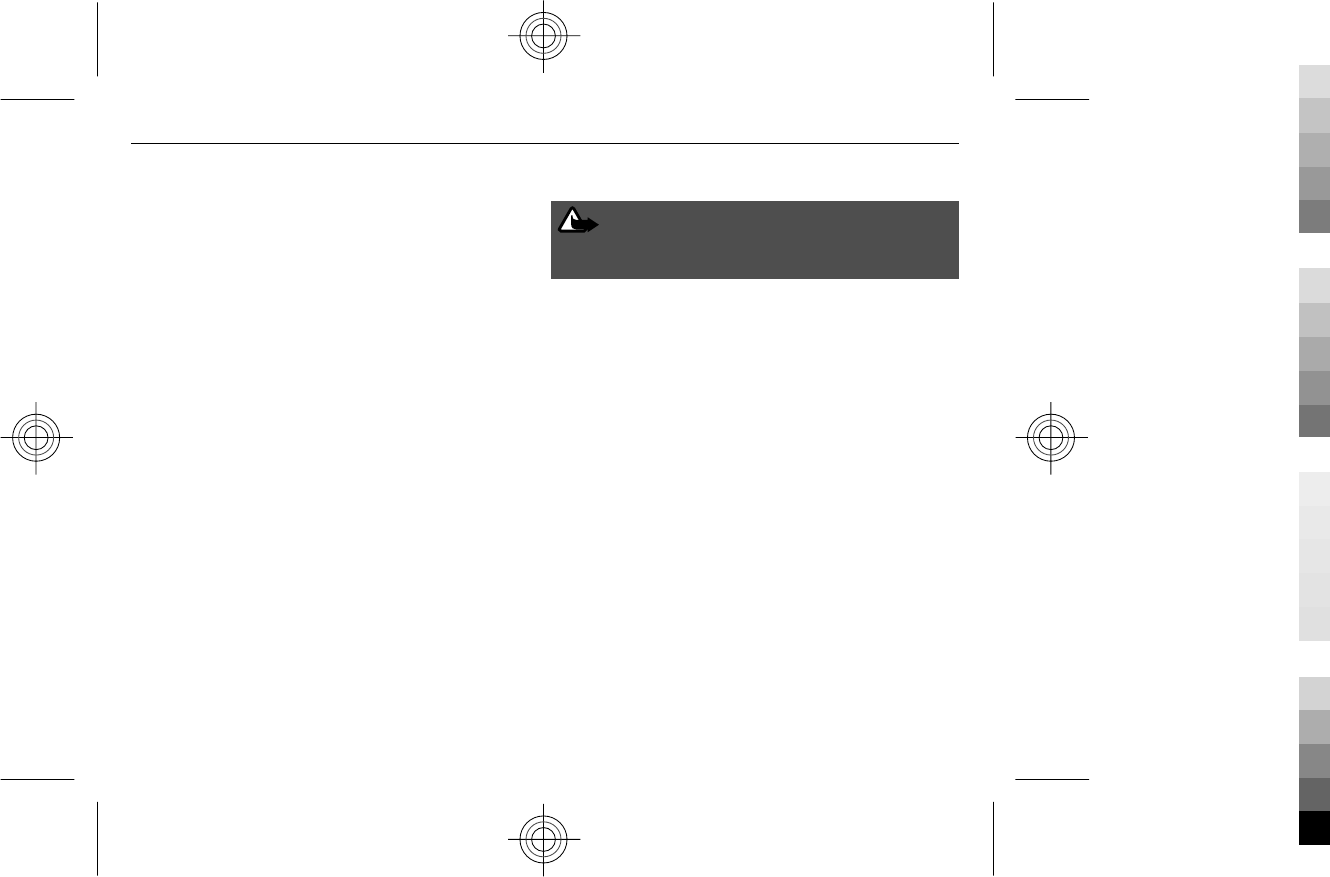
physician or the manufacturer of the medical device to determine whether they are
adequately shielded from external RF energy. Switch off the device when regulations
posted instruct you to do so, for example, in hospitals.
Implanted medical devices
Manufacturers of medical devices recommend a minimum separation of 15.3
centimetres (6 inches) between a wireless device and an implanted medical device,
such as a pacemaker or implanted cardioverter defibrillator, to avoid potential
interference with the medical device. Persons who have such devices should:
•Always keep the wireless device more than 15.3 centimetres (6 inches) from
the medical device.
•Not carry the wireless device in a breast pocket.
•Hold the wireless device to the ear opposite the medical device.
•Turn the wireless device off if there is any reason to suspect that interference
is taking place.
•Follow the manufacturer directions for the implanted medical device.
If you have any questions about using your wireless device with an implanted
medical device, consult your health care provider.
French Ministerial Order of 8th October 2003
This section only applies to France.
All Nokia products comply with international and, where adopted, country specific
standards and guidelines for limiting human exposure to electromagnetic fields.
These standards and guidelines were adopted after thorough reviews of the science.
Those reviews do not establish a link between the use of mobile devices and adverse
health effects when the device is operating within the standards and guidelines.
If you have concerns about exposure from handsets operating within the standards
or guidelines, then, in accordance with French regulatory requirements we are
required to include in this User Guide the following guidance on precautionary
measures: you can limit exposure to radio frequency energy by either (a) using the
device in good reception conditions, or (b) using a hands-free kit to move the device
away from the head and body. In the latter situation, pregnant women should keep
the device away from their abdomen and adolescents should keep the device away
from their lower abdomen.
Hearing
Warning:
When you use a headset, your ability to hear outside sounds may be affected. Do
not use a headset where it can endanger your safety.
Some wireless devices may interfere with some hearing aids.
Vehicles
Radio signals may affect improperly installed or inadequately shielded electronic
systems in motor vehicles such as electronic fuel injection, electronic antilock
braking, electronic speed control, and air bag systems. For more information, check
with the manufacturer of your vehicle or its equipment.
Only qualified personnel should install the device in a vehicle. Faulty installation or
service may be dangerous. Check regularly that all wireless device equipment in your
vehicle is mounted and operating properly. Do not store or carry flammable liquids,
gases, or explosive materials in the same compartment as the device, its parts, or
accessories. Remember that air bags inflate with great force. Do not place the device
or accessories in the air bag deployment area.
Switch off the device before boarding an aircraft. The use of wireless devices in an
aircraft may be dangerous to the operation of the aircraft and may be illegal.
Potentially explosive environments
Switch off the device in any area with a potentially explosive atmosphere. Obey all
posted instructions. Sparks in such areas could cause an explosion or fire resulting
in bodily injury or death. Switch off the device at refuelling points such as near gas
pumps at service stations. Observe restrictions in fuel depots, storage, and
distribution areas; chemical plants; or where blasting operations are in progress.
Areas with a potentially explosive atmosphere are often, but not always, clearly
marked. They include areas where you would be advised to turn off your vehicle
engine, below deck on boats, chemical transfer or storage facilities and where the
air contains chemicals or particles such as grain, dust, or metal powders. You should
check with the manufacturers of vehicles using liquefied petroleum gas (such as
propane or butane) to determine if this device can be safely used in their vicinity.
13
Cyan
Cyan
Magenta
Magenta
Yellow
Yellow
Black
Black
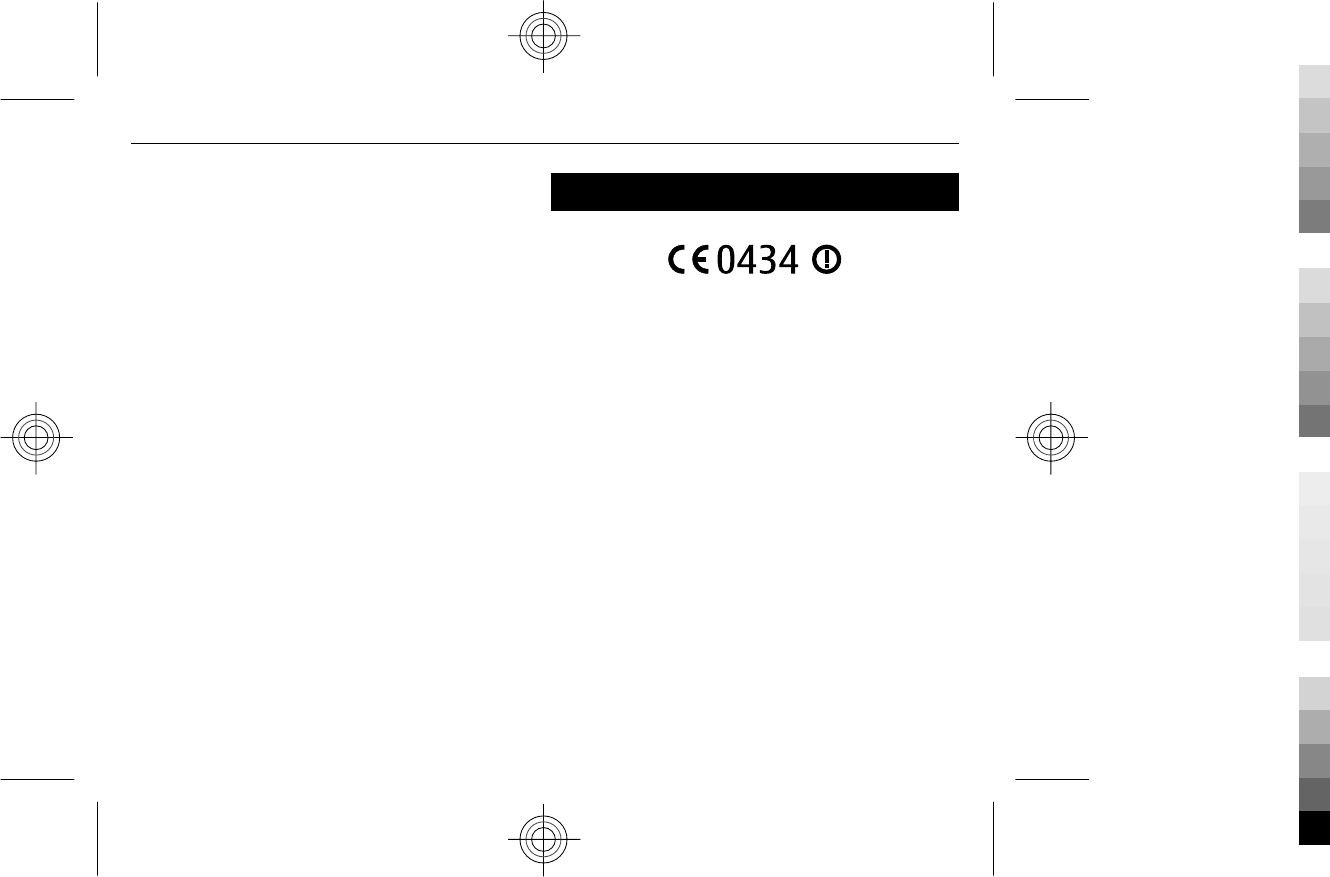
Operating environment
This device meets RF exposure guidelines in the normal use position at the ear or at
least 1.5 centimetre (5/8 inch) away from the body. Any carry case, belt clip, or holder
for body-worn operation should not contain metal and should position the device
the above-stated distance from your body.
To send data files or messages requires a quality connection to the network. Data
files or messages may be delayed until such a connection is available. Follow the
separation distance instructions until the transmission is completed.
Parts of the device are magnetic. Metallic materials may be attracted to the device.
Do not place credit cards or other magnetic storage media near the device, because
information stored on them may be erased.
Certification information (SAR)
This mobile device meets guidelines for exposure to radio waves.
This mobile device is a radio transmitter and receiver. It is designed not to exceed
the limits for exposure to radio waves recommended by international guidelines.
These guidelines were developed by the independent scientific organisation ICNIRP
and include safety margins designed to assure the protection of all persons,
regardless of age and health.
The exposure guidelines for mobile devices employ a unit of measurement known
as the Specific Absorption Rate or SAR. The SAR limit stated in the ICNIRP guidelines
is 2.0 watts/kilogram (W/kg) averaged over 10 grams of tissue. Tests for SAR are
conducted using standard operating positions with the device transmitting at its
highest certified power level in all tested frequency bands. The actual SAR level of
an operating device can be below the maximum value because the device is
designed to use only the power required to reach the network. That amount changes
depending on a number of factors such as how close you are to a network base
station.
This cellular device is also designed to meet the requirements for exposure to radio
waves established by the Federal Communications Commission (USA) and Industry
Canada. These requirements set a SAR limit of 1.6 W/kg averaged over one gram of
tissue.
Copyright and other notices
DECLARATION OF CONFORMITY
Hereby, NOKIA CORPORATION declares that this RM-680 product is in compliance with
the essential requirements and other relevant provisions of Directive 1999/5/EC. A
copy of the Declaration of Conformity can be found at www.nokia.com/phones/
declaration_of_conformity/.
© 2011 Nokia. All rights reserved.
Nokia, Nokia Connecting People, and Nokia Original Accessories logo are trademarks
or registered trademarks of Nokia Corporation. Nokia tune is a sound mark of Nokia
Corporation. Other product and company names mentioned herein may be
trademarks or tradenames of their respective owners.
Reproduction, transfer, distribution, or storage of part or all of the contents in this
document in any form without the prior written permission of Nokia is prohibited.
Nokia operates a policy of continuous development. Nokia reserves the right to make
changes and improvements to any of the products described in this document
without prior notice.
‘Dolby’ is a trademark of Dolby Laboratories.
Manufactured under license from Dolby Laboratories.
The Bluetooth word mark and logos are owned by the Bluetooth SIG, Inc. and any
use of such marks by Nokia is under license.
This product is licensed under the MPEG-4 Visual Patent Portfolio License (i) for
personal and noncommercial use in connection with information which has been
encoded in compliance with the MPEG-4 Visual Standard by a consumer engaged in
a personal and noncommercial activity and (ii) for use in connection with MPEG-4
video provided by a licensed video provider. No license is granted or shall be implied
for any other use. Additional information, including that related to promotional,
14
Cyan
Cyan
Magenta
Magenta
Yellow
Yellow
Black
Black

internal, and commercial uses, may be obtained from MPEG LA, LLC. See http://
www.mpegla.com.
To the maximum extent permitted by applicable law, under no circumstances shall
Nokia or any of its licensors be responsible for any loss of data or income or any
special, incidental, consequential or indirect damages howsoever caused.
This device is not meant for consumer markets. The device and any accompanying
material is meant for software developers only and not for sale. To the extent
permitted by applicable law(s), Nokia or its licensors shall not under any
circumstances be liable, either expressly or implicitly, for any damages or losses of
any kind whatsoever resulting from the use of the device or accompanying material,
including but not limited to, loss of, damage to, or corruption of, content or data or
the recreation or transfer thereof even if such loss, damage, or corruption was a
result of a defect in the Device.
The device and any accompanying material are provided as is. Nokia disclaims any
warranties, express or implied, including but not limited to warranties of title,
fitness for a particular purpose, merchantability, and workmanlike quality. To the
extent permitted by applicable law(s) Nokia or its licensors shall not under any
circumstances be liable for any loss or profit, products or functionality, business,
contracts, revenue or anticipated savings, increased costs or expenses, or for
anticipated savings, increased costs or expenses, or for any indirect, consequential,
incidental, special or punitive loss or damage.
Reverse engineering of software in the device is prohibited to the extent permitted
by applicable law. Insofar as this user guide contains any limitations on Nokia's
representations, warranties, damages and liabilities, such limitations shall likewise
limit any representations, warranties, damages and liabilities of Nokia's licensors.
The availability of products, features, applications and services may vary by region.
This device may contain commodities, technology or software subject to export laws
and regulations from the US and other countries. Diversion contrary to law is
prohibited.
Nokia does not provide a warranty for or take any responsibility for the functionality,
content, or end-user support of third-party applications provided with the device.
By using an application, you acknowledge that the application is provided as is.
Nokia does not make any representations, provide a warranty, or take any
responsibility for the functionality, content, or end-user support of third-party
applications provided with the device.
FCC NOTICE
The device may cause TV or radio interference (for example, when using a telephone
in close proximity to receiving equipment). The FCC can require you to stop using
your telephone if such interference cannot be eliminated. If you require assistance,
contact your local service facility. This device complies with part 15 of the FCC rules.
Operation is subject to the following two conditions: (1) This device may not cause
harmful interference, and (2) this device must accept any interference received,
including interference that may cause undesired operation. Any changes or
modifications not expressly approved by Nokia could void the user's authority to
operate this equipment.
Some operations and features are SIM card and/or network dependent, MMS
dependent, or dependent on the compatibility of devices and the content formats
supported. Some services are subject to a separate charge.
9225011/Issue 1 EN
15
Cyan
Cyan
Magenta
Magenta
Yellow
Yellow
Black
Black